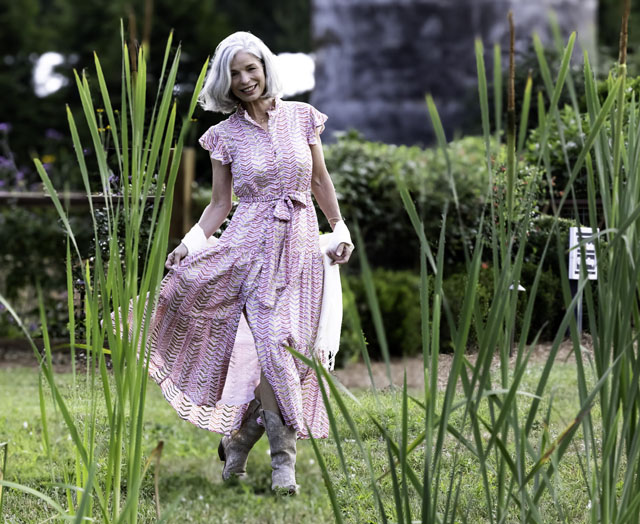Success With Container Gardens
05 Aug 2024
Understanding plant communities for successful landscape design
Story and photos by Kristin E. Landfield

Adding planted containers to your garden or entry is one of the simplest and most gratifying ways to enhance your landscape, especially seasonally. Few components in a garden provide as much style and welcome as do beautifully planted containers. Likewise, container gardening can be an excellent choice for people with limited outdoor space as long as they are selected with an appropriate scale and a simpler planting scheme. In many (not all!) cases, the smaller the space, the tighter a planting needs to be. When plants are viewed at close range and throughout the year, it is harder to ignore plants that are not thriving. This also holds true for containers directly adjacent to doors and walkways.
Another option for smaller spaces is to style a cohesive collection of pots. This styling can add a lot of charm and provide organization even if your pots are a bit smaller. Usually, this option works most successfully when the collection is a complementary unit, meaning the planters themselves relate well to one another, and the selection of plants acts as a united composition rather than a miscellaneous assortment.
Because container gardens are a closed system (i.e., all the soil, nutrients and water that a plant needs are only available in the planter itself), caring for them more frequently than those planted directly in the landscape is essential. As such, larger planters are preferable to smaller containers. Aesthetically, they provide stronger focal points and are better scaled to exterior spaces. Horticulturally, they allow plants to thrive with adequate space for root systems and nutrients. Bigger pots require less frequent watering.
For the best plant selections, myriad variables contribute to the ideal choice for your container:
» Principally, what is the right container?
» Do the desired plants grow to be large and require more space?
» Do the desired plants flower vigorously and consume more nutrients?
» How frequently are you able to water? Lifestyle is an important consideration.
» What is the architectural template or backdrop? If a house is traditional, more traditional planters are more appealing and vice versa. If a house is white, white planters can be washed out. If green plants are the backdrop, a contrast from the container itself can brighten the scene.
» If feasible, treat containers as an investment. Larger and higher quality containers cost more, but they better enhance the space and maintain the plants longer.
» Prioritize drainage. Very few plants appreciate soggy soil.
» Invest in quality soil. Soil for container gardens tends to be lighter, allowing for more expansive root growth and absorption.
» What is the desired lifespan of the planting? Choose full and showy plants if they are planted for a party or specific event. If they are planted to withstand a long growing season, choose plants that are resilient to varied growing conditions.
» What is the light exposure? In my experience, the most difficult light condition occurs when plants are shaded for much of the day and then blasted with late afternoon sun. Such exposure requires more resilient plants.
» If the pots are a matched pair, are the light conditions consistent between both pots? If the answer is no, plants that can withstand partial sun are better suited to this scenario.
» Similarly, is light on the back side consistent with that on the front? If not, and they are visible from the back, one solution is to rotate the pot from time to time so the plants receive more consistent light.
» In matched pairs, mirror the placement of the plants in the containers.
» Frost-proof pots are less likely to crack over the winter.
» Choose plants that echo. Tonal hues in the same color family can be highly appealing and elegant.
» Choose plants that contrast. For more exuberance, contrasting colors will enliven a space.
» Choose plants for calm or intimacy: greens, whites and pale, cool colors create more serenity.
» Choose plants for vibrance. Warmer colors stand out in the foreground.
» Choose plants for architecture. The form of a plant and how its shape relates to the home can offer as much appeal as flowers.
» Choose plants for texture. Frequently, the foliage itself is as important as the color.
» Consider whether planters are under eaves and porch ceilings—these will not benefit from rain or as much light
» Treat them as small gardens. Containers need gardening and care on a small scale. Grooming and deadheading prolong health and consistent flowering.
» Fertilize! Pots limit the available nutrients and best thrive with supplemental fertilizer.
» Water! Containers can dry quickly in periods of drought.
» The concept of “thrillers, fillers, and spillers” can be useful, but one that I have found to be limiting when additional options for composition and balance may work better. Not every pot needs to have a busy mix.
» Opt to plant full—a little instant gratification is satisfying and fun.
» Don’t be afraid to experiment. Even with extensive experience in container gardens, it is not always clear which plants will thrive in a given space. Trial and error often dictate the best combinations for your specific microclimate.
» Most importantly, choose plants because you like them. They are meant to be cheerful and enhance your personal space.













